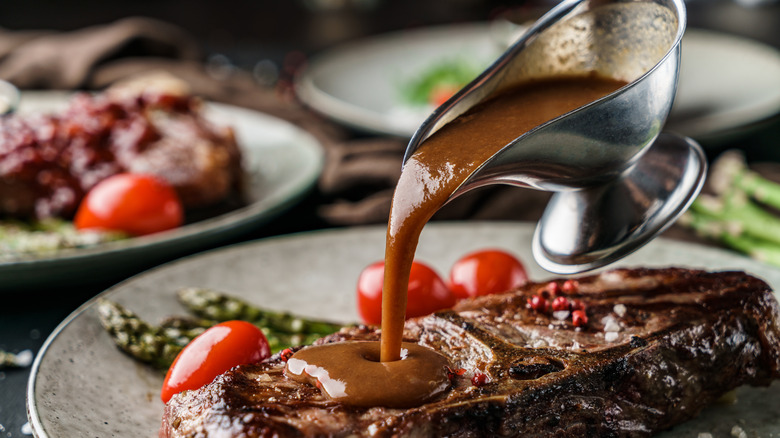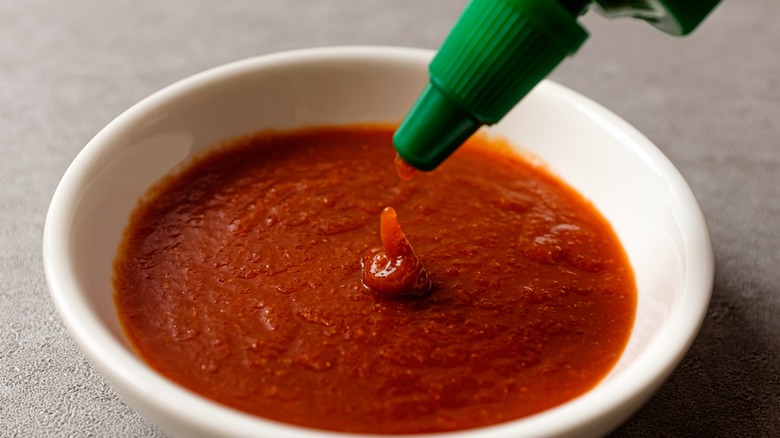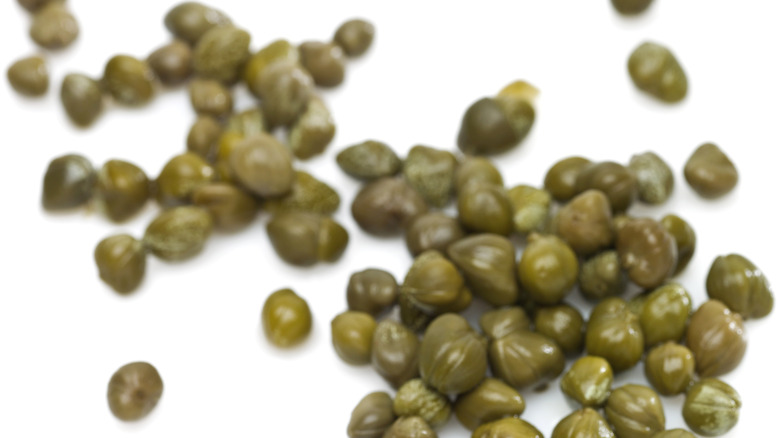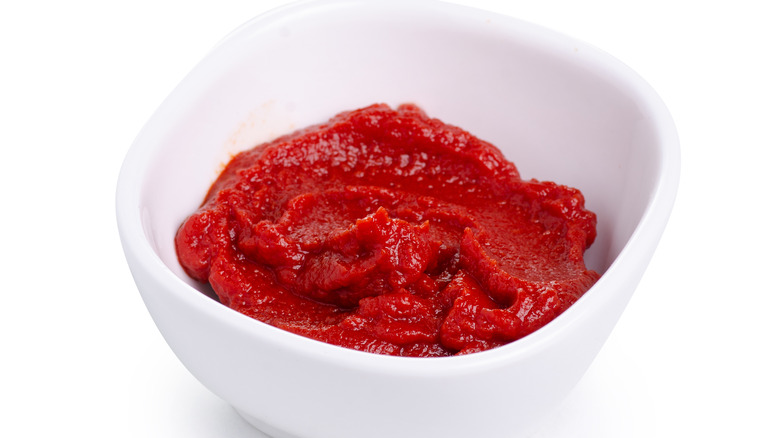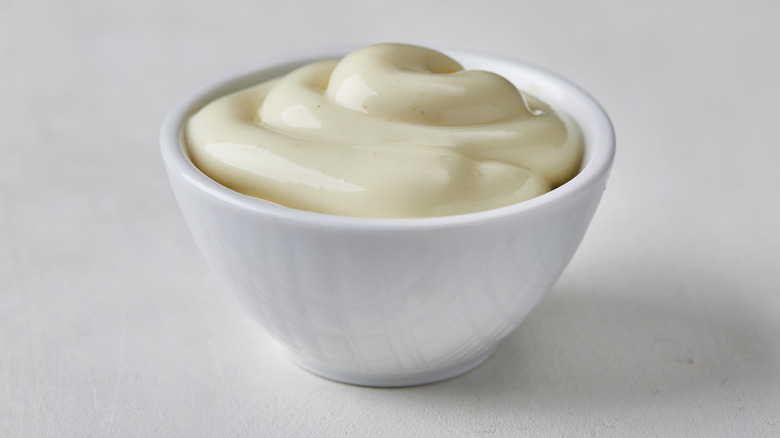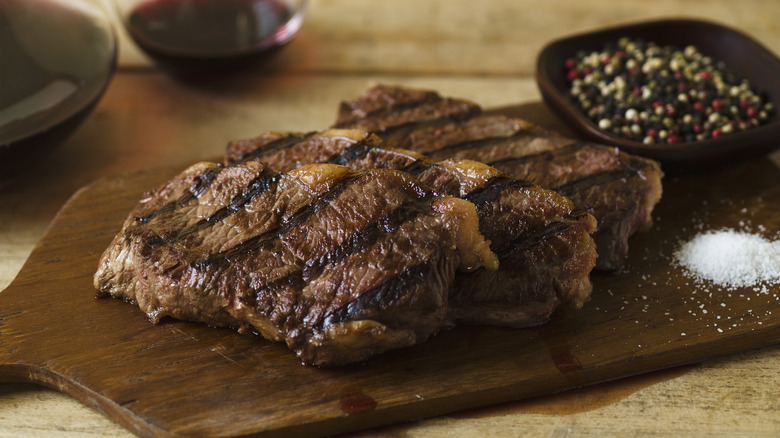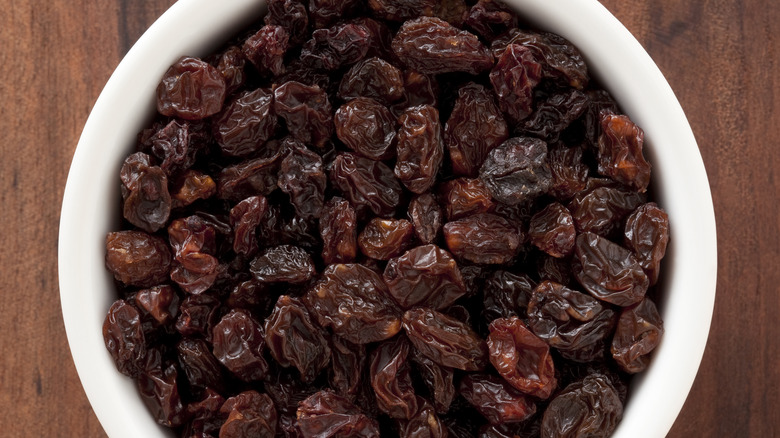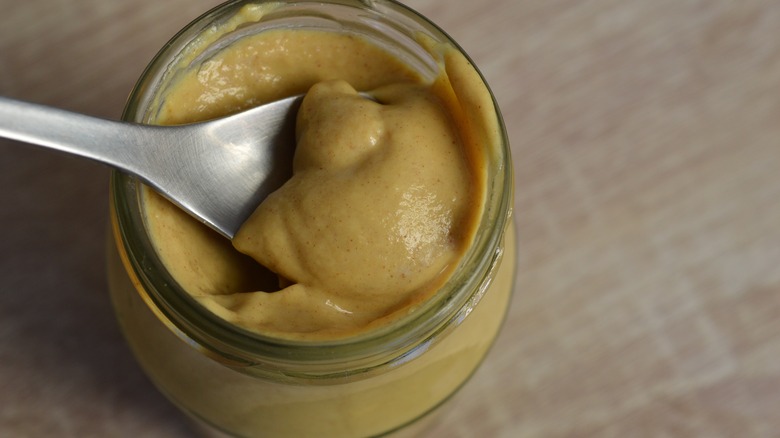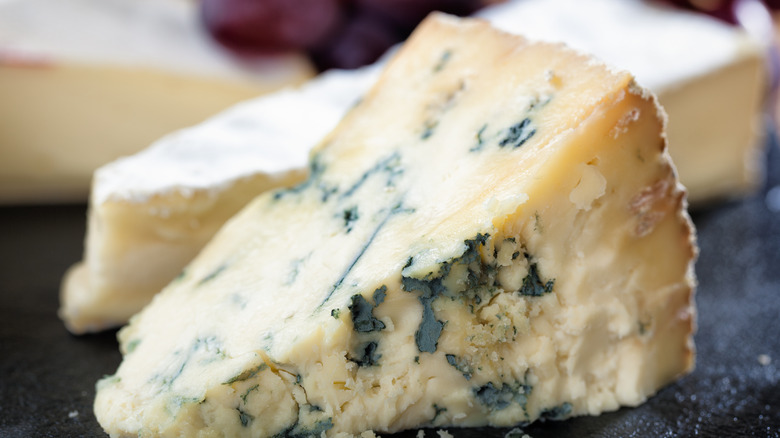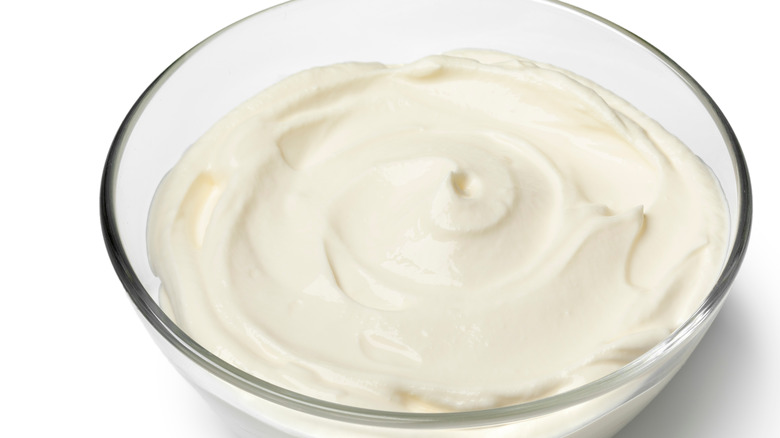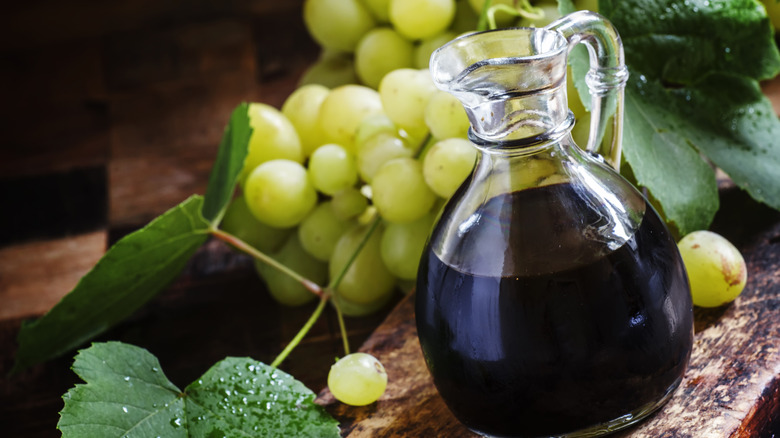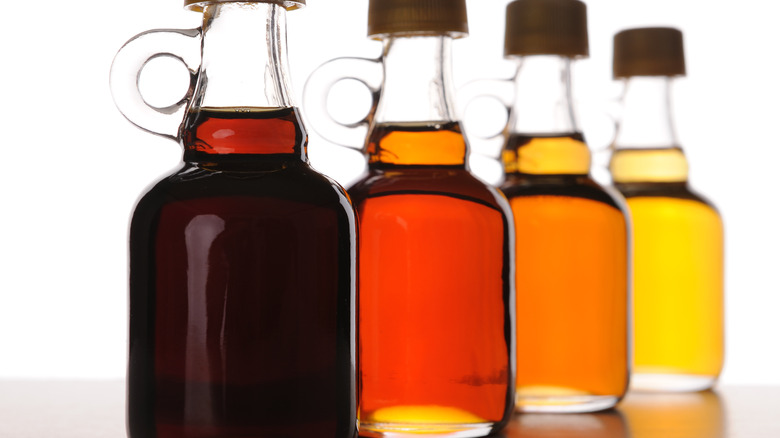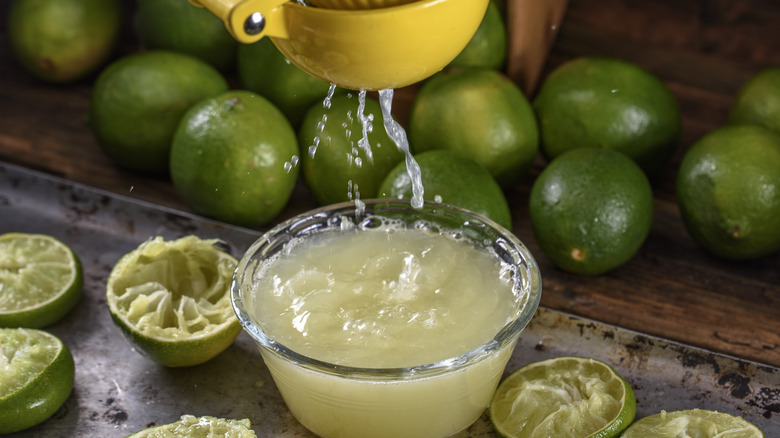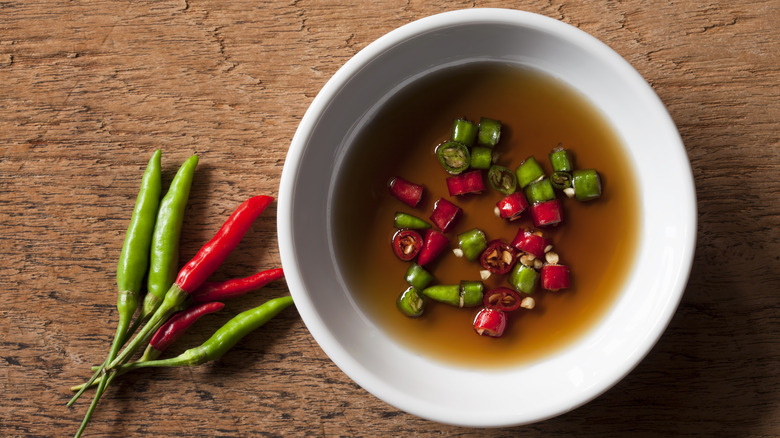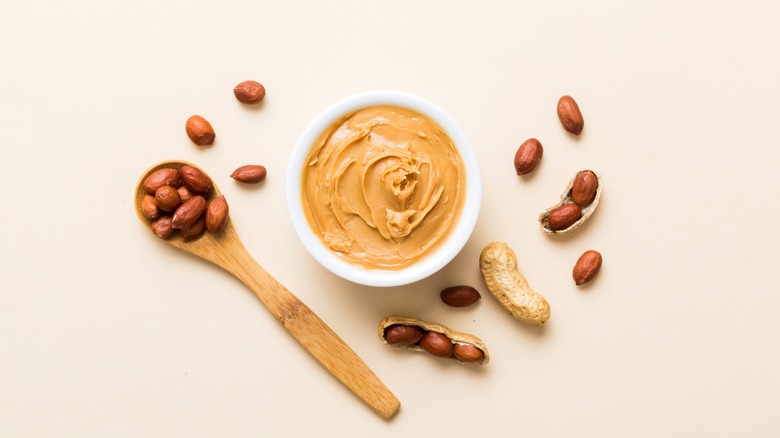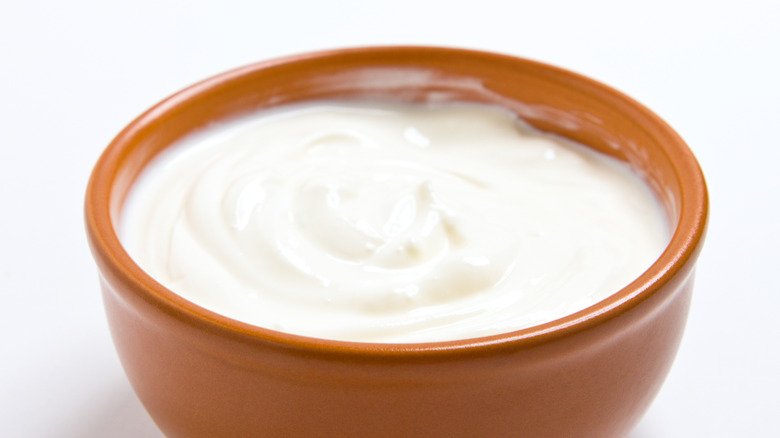18 Ingredients To Upgrade Homemade Steak Sauce
When you think of "steak sauce," what comes to mind? For us, it's not-so-fond memories of the bottle of A1 sauce in the fridge, which we always thought had an undercurrent of rancid flavor masked with savory fish. It's much more unappealing when it slides out of the bottle in a single gloop.
If you're haunted by the idea of A1 sauce, you can try making your own steak sauce at home. This task, which isn't as challenging as it seems, will allow you to control the predominant elements of a good steak sauce: sweet, savory, umami, acidic, and spicy. Once you've checked all of those boxes, you'll be well on your way to a tender cut of meat slathered in a perfect balance of flavors. Here are some of our favorite ingredients to add to homemade steak sauce that fit at least one (or multiple) of these flavor categories.
Sriracha
Every good steak sauce needs a little bit of heat. Sriracha is the flavorful ingredient addition for a spicier steak sauce. Besides adding some piquant undertones, adding this fermented sauce to your perfectly seared steak will mesh well with other ingredients like sweet ketchup, classic Worcestershire sauce, and an acidic ingredient like vinegar. The hot sauce will provide the perfect back-of-mouth heat that will elevate your steak sauce to spicy new heights.
Sriracha is made with a standard blend of chili peppers, garlic, vinegar, salt, and sugar. You can make your own homemade sriracha so you can play with the ratio of these ingredients. After you allow the mixture to ferment in a glass jar for about three days, it will be ready to blend again and drizzle into your homemade steak sauce mixture. Save the rest for drizzling on homemade avocado toast or adding to grilled chicken or tofu.
Roasted garlic
Not only will you be obsessed with eating steak covered in a roasted garlic steak sauce, but you'll also love the way your kitchen smells after roasting it. After you've prepared your cloves, you can purée them in your blender or food processor and pulse until smooth before adding them to the sauce. Roasted garlic tends to be soft to the touch, so it should be easy to blend down into a paste.
To make a simple oven-roasted garlic batch for your steak sauce, you'll only need four ingredients: a head of garlic, olive oil, salt, and pepper. Slice off the top ¼ of the bulb with a sharp kitchen knife and remove the outer peel of the allium. Then, place the head, cut-side up, in a foil wrap. Drizzle with olive oil and season your clove before baking it for about 45 minutes. You can also roast the garlic a few days ahead of time and store it in your refrigerator when needed.
Vermouth
Alcohol and steak sauce is a common pairing, but it often only comes in the form of a red wine reduction. If you want to amp up the flavor of your steak sauce, you will want to go for the liquor cabinet instead of the wine rack... kind of. Vermouth is a delicious alcoholic addition to homemade steak sauce because it has a bit of a bite to it.
Since this spirit is a fortified wine made with a botanical infusion of plants, herbs, and spices (so, it's technically not a "spirit"); the exact flavor will depend on the producer you're selecting the product from. After you've added a splash to your steak sauce, you should also store it in the refrigerator to avoid oxidation. A bottle kept properly in the fridge will last about three months — which should give you the push you need to make steak sauce more often or add it to your Boulevardier cocktail.
Capers
Capers are a delectable salty berry that almost everyone has a half-jar of in their refrigerator. It's often that you add them to your chicken piccata before forgetting about them. But we've found a new (and better) way to use this briny ingredient: steak sauce.
These berries are the perfect ingredient to finish your steak with because they have a bright, lemony tartness and the floral flavor of an olive. Following with the same spirit of piccata, we recommend pairing capers with lemons and acidic ingredients. We recommend first draining and rinsing the capers of their salty brine, as too much may upset any seasoning you add to your meat. Mix the whole berries with good olive oil, freshly minced garlic, and lemon juice for the perfect bright accompaniment to your steak dinner.
We recommend sticking with a tender cut of meat, like a flank steak, for this caper sauce. It's a bit more Mediterranean in nature and will leave you feeling light and refreshed.
Tomato paste
It's fair to say that food personality Bobby Flay knows a lot about steak. He makes thick and creamy sauce for his Salisbury steak by adding a bit of tomato paste to the mixture. Salisbury steak sauce is typically made with staple ingredients like Worcestershire sauce, Dijon mustard, ketchup, and garlic, so adding tomato paste as a thickener isn't too far off. Plus, Flay shares that this ingredient adds a slightly sweet undertone to the dish and helps thicken the sauce.
If you're not making Salisbury steak, you might also consider adding this ingredient to your steak sauce wherever ketchup is used. You'll find it deepens the umami flavor and makes the sauce a bit more tomato-forward.
Besides tomato paste, Flay also adds half-and-half to his Salisbury steak sauce to help thicken it more. This ingredient will reduce the need to add extra flour as a thickener, which will keep your sauce out of goop territory.
Mayonnaise
Man, are people just adding mayonnaise to everything nowadays? The answer is yes.
Mayonnaise is just a combination of eggs, oil, and acid. Vinegar, an acid, and oil are common ingredients in steak sauce already, so adding a bit of emulsified punch to your steak sauce recipe can really help it out. The mayonnaise is a blank canvas to create a creamy sauce. From there, you can add herby, spicy, umami, or salty flavors and make your sauce unique. There are no real rules for what you must add to this sauce to make it, which is perfect for cooks who like to experiment in the kitchen. Cuts of steak that lend well to this simple ingredient addition include filet mignon (no one will ever know it's cheap mayo) or a succulent tenderloin. This sauce also has a place with other kitchen favorites. Besides steak, you can also use a mayo-based sauce on salmon or with grilled vegetables.
MSG
MSG, or monosodium glutamate, has been unfairly villainized over the years. This seasoning is a concentrated version of the glutamate amino acid naturally found in food, so your body processes it the exact same way. It's not bad for you, contrary to popular opinion, and it can actually be a helpful ingredient to have handy in your kitchen. MSG contains some sodium, so it can replace a salty element in your sauce like capers or Worcestershire sauce. But, MSG is best used in a steak sauce as a vector for umami flavor.
The key to working with MSG in a sauce is not to overuse it. On its own, the powder imparts a strange, fish-like flavor that we think is rather unappetizing. But add a scant amount to your sauce, including one with mushrooms, fish sauce, or Worcestershire sauce, and plan to have your tastebuds blown out of the water. The powder adds an unprecedented depth that is vital for a well-rounded, umami-rich sauce.
Peppercorns
A key element in a good steak sauce is spicy. But let's face it, not every set of tastebuds is cut out for spicy. Instead of sprinkling in a burning hot sauce or spicy pepper, take a step back and utilize peppercorns for your steak sauce. You can make a brandy peppercorn steak sauce that will elevate the flavor of your meat while not overshadowing the taste and texture of the flesh.
Adding peppercorns alone would result in a steak that is difficult to eat. But this creamy sauce tames the flavors of the peppercorns and rounds it out a bit more. You'll want to use whole peppercorns for this sauce, not the kind that you'd find pre-ground at the grocery store. Crush the peppercorns in a bag with a rolling pin and pour it into the sauce once you've appropriately thickened it. You don't want to burn this ingredient, and it's important to keep stirring so the flecks are well-distributed throughout the sauce.
Raisins
Raisins might seem like the definition of an "unconventional ingredient," especially in the context of a steak. These dried grapes are the unexpected ingredient to elevate steak sauce because they produce a sweetness that is key to balancing out the flavors in your sauce. And if you've ever slathered your steak in A1 sauce, you would have already experienced the key role of raisins in the concoction.
Manufacturers started adding raisins into steak sauce as far back as the 1820s. The fruit provides the health benefits of antioxidants, which also reduce the decaying process of the meat and shield the taste of beef that's past its prime. Although refrigeration quality has improved, and it's rare to find a cut of beef that's not as fresh as can be, you can still take advantage of this fruity ingredient in your steak sauce. Add raisins to your homemade sauce, and boil them until soft and plump. This will allow for an easier blending process and a thicker texture.
Dijon mustard
Dijon mustard is the Swiss Army knife of steak sauce ingredients. Not only does it have a thick, viscous consistency that will create a sauce that stays perfectly portioned on your piece of steak, but it will also add a back-of-mouth heat that your sauce craves. Dijon mustard is different than other varieties of this condiment because it has a sharper taste, thanks to the addition of black mustard seeds and wine. Therefore, swapping it out with a simple yellow mustard isn't recommended.
Another thing that we love about Dijon mustard is that it plays well with others. You can make it into a sauce by adding fresh rosemary, garlic, thyme, and a splash of cream. If you love a salty flavor, consider adding cooked bacon or pancetta to your sauce, too. And if you're a stickler for tradition, you'll find the Dijon mustard also pairs well with classic ingredients in a steak sauce like Worcestershire sauce and brandy.
Blue cheese
Blue cheese isn't at the top of our list of cheeses that we would select from the Trader Joe's aisle. But that's not to say that this stinky cheese isn't a good match for steak.
We recommend trying a blue cheese steak sauce at least once in your culinary career. The dairy product is aromatic and punchy, which complements a steak's umami richness and tender texture. Start by sautéing shallots or onions in a pan before adding the vinegar, blue cheese crumbles (not whole pieces), Worcestershire sauce, and additional seasonings. Once you've cooked your sauce perfectly, remove it and add more blue cheese crumbles and fresh chives. This will give you both the creaminess of a thick sauce and the bright, punchy notes of fresh cheese. We recommend going with a Gorgonzola for this sauce because it's not as strong and melts well. But if you want to get creative, go right ahead with a stinkier cheese.
Crème frâiche
Have you ever cooked with crème frâiche? This French ingredient is perfect for a steak sauce because it is decadently fatty and creamy and will thicken a sauce easily. We recommend using it in a classic steak au poivre, which is a French, peppercorn-crusted steak covered in a pan sauce because the crème frâiche will mellow out the flavors of the harsh peppercorns. You can use this cooking and seasoning method for many different cuts of steak, including filet mignon, tenderloins, boneless rib, and strip steak.
To make this sauce for your steak, you're going to want to combine your leftover peppercorns with shallots and deglaze with an alcohol of choice. Then, add your stock, stir until thickened, and add your crème frâiche. Some folks will make this recipe with a heavy cream. While this ingredient will also do the job, it lacks the distinct tangy flavor of the crème frâiche.
Balsamic vinegar
Vinegar is a key element in bringing brightness and an acidic element to an otherwise overwhelming steak sauce. While apple cider and distilled white vinegar get the job done, balsamic vinegar is the more flavorful option to include in your steak sauce. It's so different from other vinegars because it's made from whole grapes rather than wine and fermented for much longer. This specific production process gives balsamic vinegar a wonderfully fruity flavor that you won't find in other vinegar varieties.
For a quick balsamic steak sauce, consider adding sugar and balsamic vinegar to the pan after you've cooked down your shallots in butter or oil. Once the sauce has thickened, you can pour it over your steaks and enjoy. You can also simmer your balsamic vinegar with more conventional steak sauce ingredients like honey, ketchup, Dijon mustard, and Worcestershire sauce. The result is a floral, subtly sweet sauce that will elevate your chosen cut of meat without overpowering it.
Maple syrup
A good steak sauce has a little bit of sweetness to it. It's important that we emphasize "little" here, as adding too much sweetener can quickly move your steak sauce from savory to sweet territory. We're after balance rather than confection, after all.
Our sweetener of choice for steak sauce is maple syrup. The flavor is moderately oaky, which can complement an alcoholic ingredient, as well as an umami-rich one like mushrooms or Worcestershire. Another key aspect of this sweetener is that it is thick, which means that it can be used to make your steak sauce more viscous without the addition of flour.
Our favorite ingredients to mix with maple syrup are bourbon, soy sauce, and lime juice. It's an excellent ingredient to add to taste or cook down with your other sauce ingredients. Just be sure to always taste the sauce as you go since combining the maple syrup with another sweet ingredient like ketchup can send things overboard.
Lime juice
If you're looking for a punchy, fresh ingredient to add to your steak sauce, look no further than lime juice. This ingredient works well as an acid with almost any combination of flavors, including fish sauce, garlic, Worcestershire, and shallots. We recommend always using fresh lime juice over the stuff in the bottle. Although the former can be a hassle to squeeze, it has a more pungent flavor that will really elevate your steak and provide you with a well-rounded sauce.
Besides adding lime juice to the sauce, you may also consider using it as a marinade ingredient. The juice will help soften up the protein and muscle fibers, which will give you a softer bite. Your steak should marinate for at least two hours and no more than 12 because the acid could break down the protein too much and leave you with a piece of meat that is a little too soft to hold up on the grill.
Fish sauce
Fish sauce isn't that strange of an ingredient in a steak sauce, considering that Worcestershire sauce contains some sort of fermented fish like anchovies. This sauce also tends to be thinner than Worcestershire, which means you have more room to play with it when you're trying to make a sauce with the perfect consistency.
One of our favorite ways to add fish sauce to a recipe is by combining it with coconut milk and curry powder. This Indo-Asian rendition of steak provides a warm heat from the spice blend with the fattiness of the curry. The fish sauce steps in and provides an umami richness and unprecedented savoriness. After trying it, you may not go back to a boring mushroom or mustard sauce again. Other flavors that mesh well with fish sauce include lime juice, soy sauce, mirin, rice wine vinegar, and fresh herbs like cilantro, which you can play with to craft your perfect Asian-inspired recipe.
Peanut butter
Peanut butter and steak? That's crazy talk. But peanut butter is actually an unexpected ingredient that can add a new dimension to your homemade sauce, specifically for thinly sliced beef. This nut butter is rather rich and creamy so it can take a heavy beating from spicy peppercorns or a savory fish sauce.
Our favorite way to use peanut butter in a steak sauce is to combine it with fresh, punchy elements like lime juice, fish sauce, and coconut milk. Since peanut butter tends to be a thick and obtrusive ingredient, you'll have to mellow it out with other ingredients with a thinner texture. It's also important to remember that the peanut will be the predominant flavor for whatever you use it in. So, if you want to make a mushroom sauce for your steak, avoid using peanut butter as an ingredient because we guarantee you'll miss out on the mushrooms.
Sour cream
Looking for a double-hitter in the thickening and tangy department? We're recommending you draft sour cream onto your roster. Sour cream doesn't have nearly the same richness as a crème frâiche, but it has the tangy profile you need to make a successful sauce — and you may not even need to add any additional vinegar.
You can whip up a quick steak sauce with sour cream, Dijon mustard, chives, and seasoning. You won't even need to cook this sauce on the stove, which makes it perfect for grilled steaks in the summertime. You can also add a scoop of sour cream to your more conventional steak sauce, along with Worcestershire sauce and beef broth. Combined with the pan drippings, this sauce makes a robust complement for any cut of meat and food outside the steak realm, including grilled chicken or pork. It's tangy, bright, and perfectly creamy.
